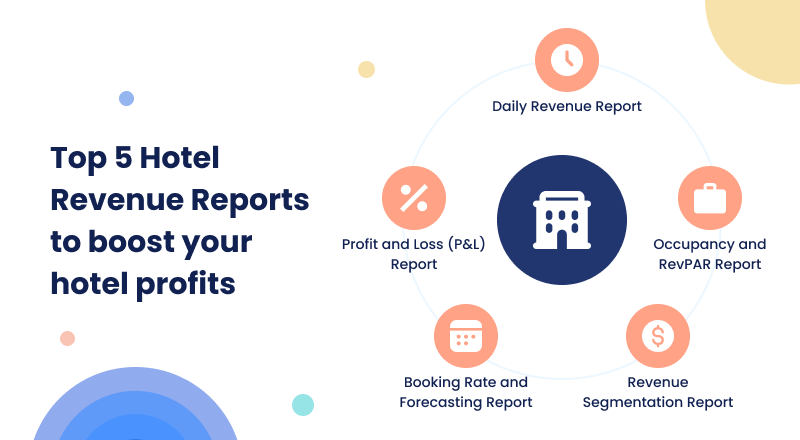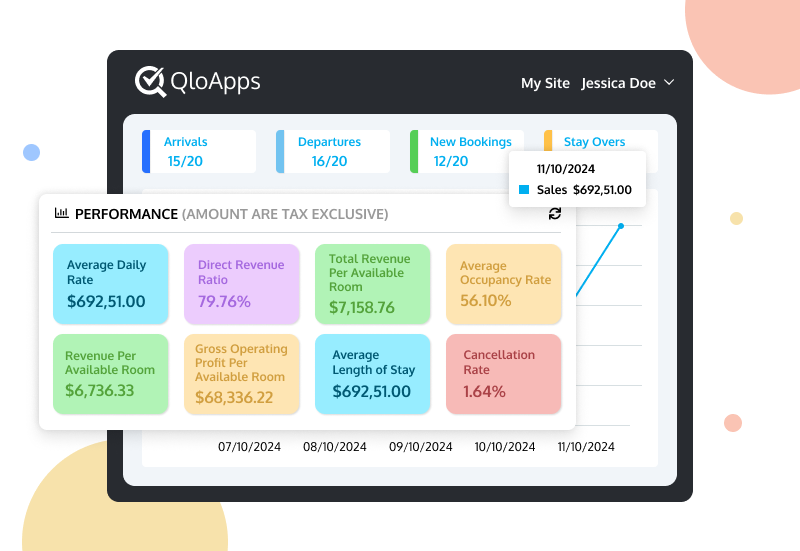Running a hotel isn’t just about filling rooms. To truly grow your profits, you need to track key revenue reports.
These reports will assist you in understanding where your money originates from and where you can improve. Let’s explore

The Top 5 Hotel Revenue Reports That Can Help Your Hotel Increase Profits
1. Daily Revenue Report: Track Your Daily-earnings
The Daily Revenue Report provides a snapshot of your hotel’s daily earnings, including:
- Room revenue from bookings, including occupancy rates and ADR.
- Additional Revenue from services like food, beverages, spa, parking, and more.
Why it’s important: This report helps you quickly identify any drops in revenue. You can also see which services are doing well.
How to use it:
- If room revenue is low, check what might be affecting bookings. You can adjust rates or run special offers to attract more guests.
- Use the data to decide when to promote other services, like dining or spa packages.
2. Occupancy And RevPAR Report: Measure Room Profitability
The Occupancy Report shows how well your rooms are being booked, while RevPAR (Revenue per Available Room) shows how much each available room generates.
By multiplying the occupancy rate with the ADR, we get RevPAR.
Why it’s important: Occupancy doesn’t show the full picture—RevPAR helps you understand if your rooms are priced right while keeping them filled.
How to use it:
- If RevPAR is low despite high occupancy, your room rates may need to be higher. Consider raising prices during busy times.
- To stay competitive, compare your RevPAR to that of your competitors.
3. Revenue Segmentation Report: Identify Your Best Revenue Sources
The Revenue Segmentation Report breaks down your earnings by room types, guest types (business, leisure), and booking channels (direct, OTA).
Importance of the report: This report enables you to understand the segments that generate maximum revenue. You can work on those areas to generate more profits.
Usage of the report:
- In case the business travelers’ revenues are higher, implement business-regulated services such as meeting rooms or expedited check-ins.
- Track booking channels to see if certain OTAs are profitable or if direct bookings generate higher margins.
4. Booking Rate And Forecasting Report: Anticipate Future Bookings.
The Booking Pace and Forecasting Report shows how fast bookings are coming in and helps you predict future occupancy.
Why it’s important: Accurate predictions allow you to manage staffing, plan inventory, and adjust pricing for future dates.
How to use it:
- If bookings are slow, consider offering discounts to fill rooms.
- Use this report to prepare for busy seasons and raise room rates when demand is high.
5. Profit And Loss (P&L) Report: Measure Your Overall Profit
The Profit and Loss (P&L) Report offers a comprehensive financial picture of your hotel. It shows your total revenue and subtracts expenses like staff salaries, utilities, and maintenance.
Why it’s important: This report helps you see if your hotel is making a profit or running at a loss. It also shows which areas may need cost-cutting.
How to use it:
- Check the profit margins for each service. If one area isn’t profitable, consider adjusting prices or cutting costs.
- Regularly check expenses like wages and utilities to ensure they aren’t eating up too much revenue.
How The QloApps Help You Track These Reports:
QloApps is a property management system that makes it simple to create and track critical revenue data. Let us see how it helps create each report.

1. Daily Revenue Report With QloApps
QloApps keeps track of the daily income generated from lodging, as well as restaurants, spas, and other services. The dashboard offers metrics instantly.
- The room Revenue: Each day reports room revenues, occupancy levels, and ADR.
- Another Revenue: Appreciate additional revenues like food, parking, etc.
2. Occupancy And RevPAR Reports With QloApps
To track Occupancy and RevPAR Trends is very simple using QloApps:
- Check Occupancy: Visualise occupancy patterns to spot trends.
- Monitor RevPAR: Easily calculate RevPAR to strike a balance between room pricing and occupancy.
It helps you price rooms competitively, especially during peak seasons, while ensuring occupancy.
3. Revenue Segmentation Report With QloApps
QloApps assists you in dissecting and understanding the different components that make up your revenue as short as possible in this manner:
- Guest types analysis: Who spaced up the most revenue businesspersons, children or rest, etc? – guest types revenue.
- Channel Tracking: Which ones made you more money in which booking channels?
Enhance your scope of operation on guests and bookings that give better revenues to overall revenues.
4. QloApps For Booking And Forecast Scheduling
QloApps helps to book pace and forecasting activities in the following ways:
- Bookings Monitoring: Check and keep records of how bookings are along the due dates.
- Business Volume Projection: Guesstimate levels of occupancy and earnings against past data.
With such forecasts, it becomes possible to manage the number of staff on duty, the pricing system in use, and most importantly prepare for busy periods.
5. P&L Report With QloApps
QloApps produces in-depth P&L statements that ascertain all the summaries of the financial standing.
- Profits Appraisal: Find out which part of your hotel fetches better returns.
- Costs Appraisal: Control and check costs like salaries and power.
Understanding earnings and costs can help you boost profitability.
Conclusion
To monitor your hotel’s financial health, regularly track these five key reports: Daily Revenue, Occupancy & RevPAR, Revenue Segmentation, Booking Pace & Forecasting, and Profit & Loss.
By making data-driven decisions, you can adjust pricing, services, and strategies to increase profits and enhance the guest experience.
With QloApps, tracking and analyzing these reports is easier, helping you make smarter decisions to grow your hotel business.

Be the first to comment.